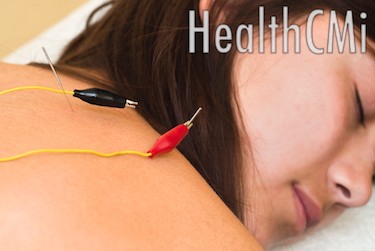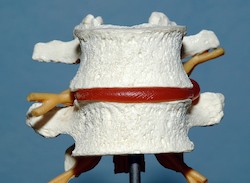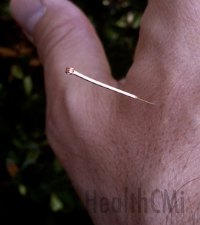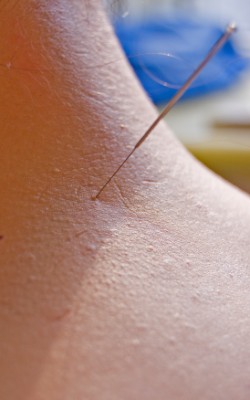Acupuncture is found more effective than drug therapy for the treatment of neck disc herniations.  This disorder is characterized by neck pain, numbness and/or weakness that often radiates towards the hands. Researchers compared electroacupuncture with the medication Meloxicam and discovered that electroacupuncture is more effective in both the short and long-term for the treatment of cervical intervertebral disc herniations.
This disorder is characterized by neck pain, numbness and/or weakness that often radiates towards the hands. Researchers compared electroacupuncture with the medication Meloxicam and discovered that electroacupuncture is more effective in both the short and long-term for the treatment of cervical intervertebral disc herniations.
A total of 420 patients were investigated in this randomized controlled study. An electroacupuncture group was compared with a Meloxicam group. Meloxicam is a nonsteroidal anti-inflammatory drug (NSAID) with analgesic and anti-febrile effects. Acupuncture was applied to acupoints GV14 (DU14, Dazhui), UB11 (BL11, Dazhu) and SI3 (Houxi). All participants were screened with strict inclusion and exclusion criteria based on objective testing including standard X-ray findings and CT (computed tomography) scans.
GV14 was needled upwards and obliquely between 0.5 to 0.7 cun. A cun is an anatomical measurement that is approximately 1 inch. SI3 was needled perpendicularly towards LI4 (Hegu) between 0.5 to 0.7 cun. Upon the arrival of de Qi needling sensation, a manual acupuncture technique of lifting and thrusting was applied with mild intensity for one minute for each of these acupuncture points. De qi is a combination of bodily sensations induced by acupuncture needling techniques combined with physiological responses to the stimulation. De qi sensation is often described as dull, heavy, deep pressure, pulling, numb, aching, spreading, radiating, electrical, refreshing, relieving and tingling. The requirements for the de Qi sensation at SI3 were that of extending to the entire hand.
GV14 and UB11 were connected by electroacupuncture stimulation with a continuous wave at 40 Hz with an intensity of 2 mA for approximately 20 minutes. Acupuncture treatments were administered once per day. A total of 10 acupuncture treatments consisted of one treatment course. A day off was taken following the first course. This was followed by another treatment course of identical procedures and quantity. The Meloxicam medication group received a 7.5 mg/tablet at a rate of once per day. The oral tablet was taken after dinner for a total of 20 days. 
Recovery was defined as a patient who is asymptomatic, has regained normal muscle strength and cervical & limb functions, is able to return to work and has a decrease in the rate of both symptoms and signs greater than or equal to 95%. Objective improvements were measured with tests including tendon reflexes, brachial plexus traction tests and spurling tests. Cervical motion was rated for improvements in lateral flexion, forward flexion, backward bending and side turning. Subjective measurements were applied to pain, tenderness and numbness scores. These measurements demonstrated that electroacupuncture proved significantly more effective in the short and long-term than the medication.
Short-Term Results
Of the 207 electroacupuncture patients, a total of 145 patients recovered in the short-term. Of the 208 medication patients, 93 recovered in the short-term. Improvements also occurred in an additional 53 acupuncture patients and 90 medication patients. A poor response was indicated by no improvement of symptoms and the decrease rate of symptoms and signs was less than or equal to 30%. The electroacupuncture group had 9 poor responses and the medication group had 25 poor responses to treatment.
Long-Term Results
Long-term results were significantly better for the electroacupuncture group than the medication group. Of the 207 electroacupuncture patients, a total of 180 patients showed recovery in the long-term. Of the 208 medication patients, 142 patients had a long-term recovery. Electroacupuncture caused 25 patients to improve significantly. The medication caused 52 medication patients to improve significantly. Poor results for electroacupuncture were limited to 2 patients and 14 medication patients had poor results. The researchers note, “With a randomized controlled multi-centered large-sampled method, this study has shown that the EA (electroacupuncture) group was better than the medication group in comparing both short-term and long-term therapeutic efficacies.”
Traditional Chinese Medicine (TCM)
The researchers documented the TCM approach to the treatment of CIDH (cervical intervertebral disc herniation). They note that CIDH is categorized in TCM as a cervical Bi-impediment and, more generally, as a bone Bi-impediment. TCM theory breaks this into several differential diagnostic patterns: invasion of wind-cold, blockage of channels, spasms of tendons and vessels, liver & kidney deficiency, tendon and bone deficiency and “loss of control of tendons.” This terminology is hermeneutic to the TCM system and is therefore widely misunderstood. For example, invasion of wind-cold can literally be morphological damage due to chronic or acute exposure to cold temperatures. The researchers add that the biomedicine view of CIDH often points to acute or repetitive trauma or strain combined with cervical disc degeneration.
The researchers give additional information on the TCM perspective of CIDH treatment and pathology. They cite research demonstrating the benefits of both acupuncture and moxibustion for enhancing neck circulation and stopping pain. The researchers note that GV 14 “is the crossing point of the Governor Vessel and three yang meridians,” it governs the yang qi of the entire body and benefits the circulation of both qi and blood.
They note that UB11 is “one of the Eight Influential Points for bones,” benefits the liver and kidney and strengthens both bones and tendons. They comment that TCM theory states that SI3 “is from the Small Intestine Meridian of Hand Taiyang,” and relaxes tendons and unblocks channels. They add that “Houxi (SI 3) is also one of the Confluent Points of the Eight Extraordinary Meridians, connecting to the Governor Vessel, so that it can unblock the meridian qi of the Governor Vessel.” Further, they note that the “Foot Taiyang Meridian follows the Hand Taiyang Meridian, and meridians can treat the diseases on their paths. Therefore, Houxi (SI 3) is effective for pain on the paths of both Governor Vessel and Foot Taiyang Meridian.”  Meridian theory and terminology is often confusing to those unfamiliar with TCM. However, acupuncture meridians are often similar to established biomedical pathways including dermatomes, myotomes and sclerotomes.
Meridian theory and terminology is often confusing to those unfamiliar with TCM. However, acupuncture meridians are often similar to established biomedical pathways including dermatomes, myotomes and sclerotomes.
References:
Wu, Yao-chi, Jun-feng Zhang, Yi-jun Sun, Cheng-fei Huang, Ping Shao, and Gui-zhen Liu. "Clinical study on electroacupuncture for cervical intervertebral disc herniation." Journal of Acupuncture and Tuina Science 11, no. 6 (2013): 371-374.
Sun SC, Sun ZG. Clinical Orthopaedics and Traumatology. Beijing: People’s Medical Publishing House, 2006: 750.
Xu LB, He YY. The effect of Du Meridian-regulating therapy on immunoglobulins in cervical intervertebral disc herniation. Shanghai Zhenjiu Zazhi, 2011, 30(9): 615-616.
Wang CM, Wu YC, Zhang JF, Huang CF. Observation on efficacy of acupoint injection combined with traction for cervical radiculopathy. J Acupunct Tuina Sci, 2011, 9(6): 380-383.
Cheng SD, Luo JS, Lu NZ, Zhang TW, Hu ZJ, Pu JS, Li W, Xu HL, Wang HF, Huang J. A randomized controlled trial of warm needling moxibustion plus sitting-position pulling and stretching manipulation for the treatment of cervical spondylotic vertebral arteriopathy. Shanghai Zhenjiu Zazhi, 2012, 31(6): 410-413.
Sampath P, Bendebba M, Davis JD, Ducker T. Outcome in patients with cervical radiculopathy: prospective, multicenter study with independent clinical review. Spine (Phila Pa 1976), 1999, 24(6): 591-597.


